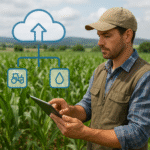Agricultural landscapes are undergoing a radical transformation as farmers and researchers embrace groundbreaking methods to combat climate change while generating additional revenue. Carbon Farming: Turning Emissions into Income explores how innovative practices in the realm of sustainable agriculture are not only capturing excess greenhouse gases but also delivering economic incentives for land stewards. By integrating cutting-edge strategies, this movement redefines the role of farms as active players in the global effort to reduce atmospheric carbon dioxide.
Principles of Carbon Farming
At its core, carbon farming focuses on enhancing the ability of soils and vegetation to capture and store carbon through a mix of agronomic techniques. The practice revolves around three pillars: carbon sequestration, improved soil health, and increased biodiversity. Each component interrelates, creating a resilient system that draws down CO₂ levels while promoting productive ecosystems.
Key elements include:
- Regenerative soil management: Incorporating minimal tillage, cover cropping, and organic amendments to rebuild soil structure and organic matter content.
- Agroforestry systems: Planting trees and shrubs within cropland or pasture to enhance agroforestry benefits such as nutrient cycling, shade, and habitat provision.
- Precision grazing: Managing livestock intensity and rotation to stimulate plant regrowth, prevent overgrazing, and encourage carbon retention in grasslands.
- Wetland restoration: Reestablishing marshes and riparian buffers to stabilize soils, filter pollutants, and capture carbon in peat and biomass.
When combined thoughtfully, these strategies transform conventional fields into dynamic carbon sinks, delivering a range of environmental services and unlocking new funding streams tied to carbon markets.
Innovative Techniques and Technologies
Emerging technologies are vital to measuring and optimizing carbon capture. Advanced tools lend credence to carbon farming claims and streamline participation in carbon credits programs. Below are some breakthroughs reshaping the industry:
- Remote sensing and satellite imagery: High-resolution data reveal changes in vegetation cover and soil moisture, enabling precise quantification of carbon stock variations over time.
- Soil spectroscopy: Portable scanners analyze soil composition and organic matter content, providing immediate feedback on regenerative efforts.
- Biological inoculants: Microbial enhancements, including mycorrhizal fungi and nitrogen-fixing bacteria, accelerate organic matter formation and stabilize soil aggregates.
- Blockchain verification: Distributed ledger technology ensures transparent, tamper-proof records of carbon offsets, bolstering credibility for buyers and sellers.
By integrating these innovations, farmers can confidently enter carbon marketplaces and demonstrate verifiable emissions reduction. Moreover, these tools foster data-driven decisions, letting practitioners refine practices for maximum impact.
Economic Benefits and Market Dynamics
Financial incentives are pivotal in driving the uptake of carbon farming. Farmers can monetize captured carbon via voluntary or compliance markets, diversify income streams, and reduce dependency on volatile commodity prices. The offset credits generated through verified sequestration efforts command premiums, especially when bundled with co-benefits like improved biodiversity and enhanced water retention.
Key economic pathways include:
- Sale of carbon credits: Each metric ton of CO₂e sequestered can be traded, with prices varying regionally—commonly ranging from $10 to over $50 per ton, depending on project quality and certification.
- Premium crop contracts: Buyers seeking climate-friendly produce often pay higher rates for goods grown under verified carbon-reducing protocols.
- Government incentives: Subsidies, tax breaks, and grants support farmers who adopt sustainable practices, offsetting initial investment costs.
- Eco-tourism and branding: Farms that highlight their environmental stewardship attract visitors and open direct-to-consumer sales opportunities under green labels.
For many producers, carbon farming evolves into a multifunctional enterprise that not only mitigates climate risk but also strengthens rural livelihoods and community resilience.
Implementation Challenges and Future Perspectives
Despite promising outcomes, carbon farming faces obstacles requiring careful navigation. Standardizing measurement protocols, ensuring equitable land tenure, and aligning stakeholder incentives remain critical. Smallholders may lack access to capital, technical training, or transparent markets, potentially creating inequities in program participation.
Overcoming barriers
- Capacity building: Extension services and cooperative networks can deliver training on soil testing, certification processes, and best management practices.
- Policy harmonization: Governments and international bodies need to align carbon accounting frameworks to simplify cross-border credit trading and reduce transaction costs.
- Inclusive financing: Microloans, blended finance models, and public–private partnerships can bankroll upfront expenses for resource-poor farmers.
Looking ahead
As global focus intensifies on climate mitigation, carbon farming is poised to scale dramatically. Collaboration among agronomists, technologists, policymakers, and market actors will drive innovation, better quantify outcomes, and democratize access. By weaving robust monitoring systems with adaptive management, the agricultural sector can emerge as a cornerstone of carbon neutrality efforts.
Strategic priorities for the next decade include:
- Enhancing measurement precision to bolster confidence in carbon markets
- Expanding multi-stakeholder partnerships to align ethical, environmental, and economic goals
- Leveraging digital platforms for real-time data sharing and credit brokerage
- Promoting cross-scale integration, from small farms to landscapes, ensuring connectivity of carbon reservoirs
Carbon Farming: Turning Emissions into Income demonstrates that with the right blend of innovation, policy support, and community engagement, the agriculture sector can become a net carbon sink, transforming the traditional view of farms from mere producers of food to guardians of the planet’s climate stability.










